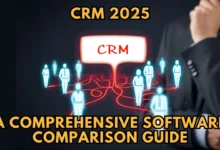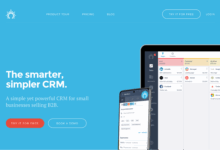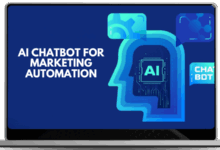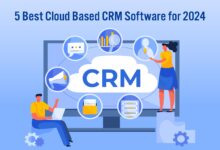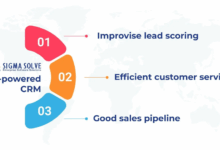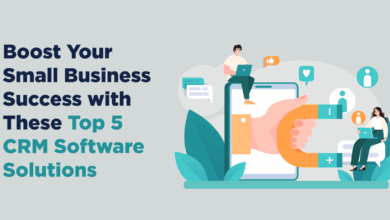Best Enterprise CRM Solutions: A Comprehensive Guide
Best Enterprise CRM Solutions are crucial for large organizations navigating complex customer relationships. This guide delves into the essential aspects of selecting, implementing, and maximizing the return on investment (ROI) of enterprise CRM systems. We’ll explore leading vendors, key features, implementation strategies, security considerations, and future trends shaping this dynamic landscape.
From defining your specific enterprise needs and comparing deployment models (cloud, on-premise, hybrid) to understanding the intricacies of integration, data security, and cost analysis, we aim to provide a holistic understanding of enterprise CRM. We will also highlight the crucial role of advanced analytics and reporting in driving data-informed decision-making and improving sales processes and customer service.
Defining Enterprise CRM Needs
Selecting the right Enterprise CRM system is crucial for streamlining operations and driving growth. A well-implemented CRM can significantly improve customer relationships, boost sales efficiency, and enhance overall business performance. However, choosing the appropriate solution requires a thorough understanding of your specific enterprise needs and how a CRM can address them.
Core Functionalities of Enterprise CRM Systems encompass a broad range of capabilities extending beyond basic contact management. These systems need to integrate seamlessly with existing business applications, provide robust reporting and analytics dashboards, and offer scalable solutions to accommodate future growth.
Key Differences Between CRM Solutions for Small Businesses and Large Enterprises
Small business CRM solutions often focus on basic contact management, sales tracking, and simple reporting. They prioritize ease of use and affordability, often utilizing cloud-based models with limited customization options. In contrast, enterprise CRM systems demand more sophisticated functionalities. They need to handle significantly larger volumes of data, integrate with multiple complex systems across different departments (like finance, marketing, and supply chain), and offer advanced analytics and automation capabilities for complex business processes. Furthermore, enterprise solutions often require higher levels of security and customization to meet the unique needs of large organizations with diverse operational requirements and compliance regulations. For example, a small bakery might use a CRM to track customer orders and preferences, while a multinational corporation would leverage a CRM to manage complex sales cycles, track customer interactions across multiple channels, and analyze vast amounts of data to identify trends and opportunities.
Enterprise CRM Deployment Models
The choice of deployment model significantly impacts cost, scalability, security, and maintenance. Each model presents distinct advantages and disadvantages, necessitating careful consideration based on specific organizational needs and resources.
| Deployment Model | Cost | Scalability | Security | Maintenance |
|---|---|---|---|---|
| Cloud-Based | Typically lower upfront costs; subscription-based pricing; potential for variable costs based on usage. | Highly scalable; easily adaptable to changing business needs; capacity can be adjusted as required. | Relies on the vendor’s security infrastructure; often includes robust security measures; data location and compliance need consideration. | Vendor-managed; updates and maintenance handled by the provider; reduced internal IT burden. |
| On-Premise | Higher upfront investment in hardware and software; ongoing maintenance and IT support costs. | Scalability requires significant upfront planning and investment in infrastructure; expansion can be complex and costly. | Greater control over data security and infrastructure; requires dedicated internal IT resources and expertise for management. | Requires dedicated internal IT staff for maintenance, updates, and security patches; higher operational costs. |
| Hybrid | Moderate upfront costs; combination of subscription and on-premise expenses; balance of scalability and control. | Offers a balance between cloud scalability and on-premise control; allows for selective deployment of specific functionalities. | Combines the security features of both models; requires careful management of data security across different environments. | Shared responsibility between vendor and internal IT; requires coordination and management of multiple systems. |
Top Enterprise CRM Vendors
Selecting the right Enterprise CRM solution is crucial for business success. The market offers a wide array of options, each with its own strengths and weaknesses. Understanding the key players and their capabilities is essential for making an informed decision. This section will explore some of the leading vendors and their respective offerings.
Choosing the best Enterprise CRM often depends on specific business needs and existing infrastructure. Factors such as industry, company size, budget, and integration requirements all play a significant role. A thorough evaluation of these factors is critical before committing to a particular vendor.
Leading Enterprise CRM Providers
Several vendors dominate the enterprise CRM market, each offering a comprehensive suite of tools and features. These include Salesforce, Microsoft Dynamics 365, and SAP CRM, among others. Oracle Siebel and Adobe Experience Cloud also hold significant market share, particularly within specific industry niches. However, this section will focus on the three most commonly discussed and widely implemented systems.
Comparison of Salesforce, Microsoft Dynamics 365, and SAP CRM
Salesforce, Microsoft Dynamics 365, and SAP CRM are three leading contenders in the enterprise CRM space. While all three offer robust features, they cater to different needs and preferences. Salesforce is known for its extensive app ecosystem and customization options, making it highly adaptable. Microsoft Dynamics 365 boasts strong integration with other Microsoft products, offering seamless workflow for businesses already invested in the Microsoft ecosystem. SAP CRM, on the other hand, excels in complex, large-scale deployments, often preferred by multinational corporations with intricate business processes. However, Salesforce can be expensive, requiring significant investment in both licensing and customization. Microsoft Dynamics 365, while generally more affordable, may require more extensive integration efforts for businesses not already using Microsoft products. SAP CRM, due to its complexity, demands a higher level of technical expertise for both implementation and maintenance.
Key Features of Salesforce, Microsoft Dynamics 365, and SAP CRM
The following bullet points highlight key features offered by each vendor. These features represent a core subset of their capabilities; each system offers a much broader range of functionalities.
- Salesforce: Sales Cloud (sales force automation, lead management, opportunity tracking), Service Cloud (customer service case management, knowledge base), Marketing Cloud (email marketing, social media marketing, campaign management), Sales Analytics, AppExchange (extensive third-party app integrations).
- Microsoft Dynamics 365: Sales (lead management, opportunity management, forecasting), Customer Service (case management, knowledge base, omnichannel support), Marketing (email marketing, campaign management, lead nurturing), Field Service (scheduling, dispatching, mobile workforce management), strong integration with Microsoft Office 365 and Azure.
- SAP CRM: Sales and service support, marketing automation, comprehensive analytics and reporting, strong integration with other SAP enterprise applications, robust data management capabilities tailored for large enterprises.
Key Features and Functionality
Selecting the right enterprise CRM involves careful consideration of its core features and functionalities. A robust system goes beyond basic contact management; it should streamline operations, improve decision-making, and ultimately drive business growth. The following sections detail key aspects to consider.
Integration Capabilities in Enterprise CRM
Seamless integration is paramount for an effective enterprise CRM. A siloed system, unable to communicate with other crucial business applications, hinders efficiency and data accuracy. Successful integration allows for a unified view of customer data, eliminating redundancies and improving data quality. For example, integrating the CRM with an ERP system allows for real-time updates on sales orders and inventory levels, providing a complete picture of the customer journey and facilitating better forecasting. Similarly, integration with marketing automation tools enables targeted campaigns and personalized customer interactions, leading to higher conversion rates. Effective integration minimizes manual data entry, reduces errors, and creates a more streamlined workflow across different departments.
Advanced Analytics and Reporting in Enterprise CRM Decision-Making
Advanced analytics and reporting are crucial for extracting meaningful insights from the vast amounts of customer data stored within an enterprise CRM. These capabilities go beyond basic reporting, offering predictive analytics, data visualization, and custom dashboards. For instance, analyzing sales data can reveal trends in customer behavior, allowing businesses to proactively adjust their strategies. Predictive analytics can forecast future sales, identify at-risk customers, and optimize resource allocation. Data visualization tools present complex data in an easily understandable format, making it simpler for decision-makers to identify key trends and patterns. This data-driven approach allows for more informed decisions, improved resource allocation, and ultimately, better business outcomes. For example, a company might identify a segment of customers with high churn rates and use this information to develop targeted retention strategies.
CRM Software’s Impact on Sales Processes and Customer Service
Enterprise CRM software significantly enhances both sales processes and customer service. On the sales side, CRM streamlines the sales cycle by automating tasks such as lead management, opportunity tracking, and sales forecasting. Sales teams gain a centralized view of customer interactions, allowing for more personalized and effective communication. This leads to improved sales conversion rates and increased revenue. In customer service, CRM provides agents with a complete history of customer interactions, enabling them to provide faster, more efficient, and personalized support. Features like automated ticketing systems and knowledge bases improve response times and resolve issues more quickly, leading to increased customer satisfaction and loyalty. For example, a customer service agent can access a complete history of a customer’s interactions with the company, including past purchases, support tickets, and communication logs, enabling them to provide a more personalized and efficient service experience.
Implementation and Integration
Successfully implementing an enterprise CRM system requires careful planning and execution. The process is complex, involving significant technical and organizational changes, and demands a strategic approach to minimize disruption and maximize return on investment. A phased approach, coupled with effective change management, is crucial for a smooth transition.
Stages of Enterprise CRM Implementation
A typical enterprise CRM implementation follows a series of well-defined stages. These stages build upon each other, and a robust plan is necessary to ensure each stage is completed successfully before proceeding to the next. Ignoring this sequential process can lead to significant setbacks and increased costs.
- Planning and Requirements Gathering: This initial phase involves defining the project scope, identifying key stakeholders, and meticulously documenting business requirements. This includes determining which functionalities are essential, understanding user needs, and mapping out the desired workflows within the CRM system. A comprehensive needs analysis should be conducted to identify specific pain points the CRM is intended to address.
- Selection and Procurement: After thorough evaluation of various CRM solutions (as discussed previously), the optimal system is selected based on features, cost, and scalability. Negotiations with the vendor are conducted, and a contract is finalized, outlining implementation timelines, support services, and other crucial terms.
- System Configuration and Customization: The selected CRM system is configured to meet the specific requirements outlined in the planning phase. This might involve customizing workflows, dashboards, and reports. Data fields are defined and tailored to match the organization’s existing data structures. This stage frequently involves close collaboration between the IT department and the CRM vendor.
- Data Migration: This critical phase involves transferring existing customer data from legacy systems into the new CRM. A meticulous plan is required to ensure data accuracy, consistency, and completeness. This often involves data cleansing, transformation, and validation to ensure data integrity within the new system. Data mapping is a crucial component to connect old and new data fields correctly.
- Testing and User Acceptance Testing (UAT): Before full deployment, rigorous testing is performed to identify and resolve any bugs or issues. User Acceptance Testing involves end-users evaluating the system to ensure it meets their needs and expectations. This feedback is crucial for making necessary adjustments before going live.
- Training and Go-Live: Comprehensive training is provided to end-users on how to effectively utilize the new CRM system. The go-live phase involves deploying the system to the entire organization, transitioning from the old system to the new one. Post-implementation support is crucial to address any immediate challenges that arise.
- Post-Implementation Support and Optimization: After the initial go-live, ongoing support is provided to address any issues and optimize the system’s performance. Regular system reviews and updates are conducted to ensure the CRM remains effective and efficient.
Challenges of CRM System Integration
Integrating a new CRM system with existing enterprise software presents numerous challenges. These challenges often stem from compatibility issues, data inconsistencies, and the need for robust data synchronization mechanisms. Effective planning and collaboration between IT and business units are critical to mitigating these risks.
One major challenge is ensuring seamless data flow between the CRM and other systems, such as ERP (Enterprise Resource Planning), marketing automation platforms, and e-commerce systems. Different systems may use different data formats and structures, requiring custom integrations or middleware solutions to bridge these gaps. Data synchronization can be complex, requiring real-time updates or scheduled batch processes to maintain data consistency across all systems. Security is another critical concern, ensuring data integrity and preventing unauthorized access across integrated systems.
Data Migration Process Flowchart
A well-defined flowchart visually represents the data migration process. This helps to ensure a structured and systematic approach, minimizing errors and delays.
The flowchart would begin with a “Start” node. This would be followed by a “Data Assessment and Cleansing” step, which involves identifying and correcting any inconsistencies or errors in the existing data. Next, a “Data Mapping” step would define the correspondence between fields in the legacy system and the new CRM. This would be followed by “Data Transformation”, converting data into the format required by the CRM. Then, a “Data Validation” step would verify the accuracy and completeness of the transformed data. The next step would be “Data Migration Execution”, where the data is transferred to the CRM. A “Data Verification” step would follow, comparing the data in both systems to ensure accuracy. Finally, a “End” node signifies the completion of the process. Each step would be represented by a box in the flowchart, with arrows indicating the flow of the process.
Cost and Return on Investment (ROI)
Implementing an enterprise CRM system represents a significant investment, but the potential return can be substantial. Understanding the various cost factors and how to calculate ROI is crucial for justifying the expenditure and ensuring successful deployment. This section will outline the key cost components and provide a framework for assessing the financial benefits of adopting an enterprise CRM solution.
Cost Factors Associated with Enterprise CRM Systems
The total cost of ownership (TCO) for an enterprise CRM system extends beyond the initial licensing fees. Several factors contribute to the overall expense, and a thorough understanding of these is vital for accurate budgeting and financial planning. These factors include upfront costs and ongoing maintenance expenses.
| Cost Category | Description | Example Costs | Considerations |
|---|---|---|---|
| Licensing Fees | The cost of purchasing the CRM software licenses, typically based on the number of users or features required. | $50 – $200+ per user per month | Consider tiered pricing and potential discounts for large deployments. |
| Implementation Costs | Expenses associated with configuring, customizing, and deploying the CRM system, including consulting fees, data migration, and system integration. | $10,000 – $100,000+ | Thorough planning and scoping are critical to minimize these costs. |
| Training Costs | Costs associated with training employees on how to effectively use the new CRM system. This includes instructor-led training, online modules, and documentation. | $500 – $5,000+ per employee | Effective training is crucial for user adoption and maximizing ROI. |
| Ongoing Support and Maintenance | Recurring costs for technical support, software updates, bug fixes, and system maintenance. | $1,000 – $10,000+ per year | Consider service level agreements (SLAs) to ensure timely support. |
Calculating the ROI of an Enterprise CRM System
Calculating the ROI of an enterprise CRM system involves comparing the total cost of ownership with the financial benefits achieved through improved customer relationship management. A simple ROI calculation can be expressed as follows:
ROI = (Net Benefits – Total Costs) / Total Costs
Net benefits include increased revenue, reduced costs, and improved efficiency. Total costs encompass all expenses associated with the CRM system, as detailed in the previous section. Accurate forecasting of these benefits and costs is essential for a reliable ROI calculation.
Potential Cost Savings and Revenue Increases
Implementing an effective CRM system can lead to significant cost savings and revenue increases. The following table illustrates potential areas of improvement and their financial impact. These figures are illustrative and will vary based on specific business circumstances and the CRM system’s effectiveness.
| Area of Improvement | Cost Savings | Revenue Increase | Example |
|---|---|---|---|
| Improved Sales Efficiency | Reduced sales cycle time | Increased sales conversion rates | A 10% reduction in sales cycle time and a 5% increase in conversion rates could significantly boost revenue. |
| Reduced Customer Churn | Lower customer acquisition costs | Increased customer lifetime value | Reducing churn by 5% could result in substantial savings on reacquisition efforts. |
| Improved Customer Service | Reduced support call handling time | Increased customer satisfaction and loyalty | Faster resolution times and improved customer satisfaction can lead to increased repeat business. |
| Enhanced Marketing Effectiveness | Targeted marketing campaigns | Improved lead generation and conversion | Personalized marketing efforts can improve campaign ROI by focusing resources on high-potential leads. |
Security and Compliance
Protecting sensitive customer and business data is paramount when choosing and implementing an enterprise CRM system. Robust security measures and adherence to relevant regulations are not optional; they are essential for maintaining trust, avoiding legal penalties, and ensuring business continuity. This section details crucial security considerations and compliance best practices for enterprise CRM deployments.
Data encryption, access control, and regulatory compliance are interconnected pillars of a secure CRM environment. Data breaches can lead to significant financial losses, reputational damage, and legal repercussions. Therefore, a multi-layered approach to security is vital.
Data Encryption and Access Control
Effective data encryption protects sensitive information both in transit and at rest. This involves using strong encryption algorithms to scramble data, rendering it unreadable without the correct decryption key. Access control mechanisms, such as role-based access control (RBAC), restrict user access to only the data and functionalities they require to perform their jobs. Implementing multi-factor authentication (MFA) adds an extra layer of security, requiring users to provide multiple forms of authentication before accessing the system. For example, a company might use a combination of a password, a security token, and biometric authentication to verify user identity. This layered approach minimizes the risk of unauthorized access even if one security layer is compromised.
Compliance with GDPR, CCPA, and Other Regulations
Adherence to data privacy regulations like the General Data Protection Regulation (GDPR) in Europe and the California Consumer Privacy Act (CCPA) in the United States is critical. These regulations stipulate how personal data must be collected, processed, stored, and protected. Compliance requires implementing measures such as data minimization (collecting only necessary data), providing data subjects with control over their data (right to access, rectification, erasure), and ensuring data security through appropriate technical and organizational measures. Failure to comply can result in substantial fines and legal action. For instance, a company failing to meet GDPR requirements could face fines up to €20 million or 4% of annual global turnover, whichever is higher.
Data Backups and Disaster Recovery Planning
Regular data backups are crucial for business continuity and data recovery in case of unforeseen events like hardware failures, cyberattacks, or natural disasters. A comprehensive disaster recovery plan outlines procedures for restoring CRM data and functionalities to minimize downtime and data loss. This plan should include offsite backups, regular testing of recovery procedures, and a clear communication strategy to keep stakeholders informed during an incident. For example, a company might use a cloud-based backup solution to store copies of its CRM data in a geographically separate location, ensuring data availability even if the primary data center is affected by a disaster. The plan should also detail how user access will be restored and business operations resumed following a data loss event.
Best Practices for Data Security and Compliance
Implementing a robust security posture requires a multifaceted approach. Regular security audits and penetration testing identify vulnerabilities and weaknesses in the system. Employee training programs educate staff on security best practices, such as recognizing phishing attempts and creating strong passwords. Continuous monitoring of system logs and security alerts helps detect and respond to potential threats promptly. Furthermore, regular updates and patching of the CRM software and underlying infrastructure are essential to address known vulnerabilities and prevent exploitation by malicious actors. A comprehensive security information and event management (SIEM) system can centralize security logs from various sources, providing a holistic view of the security posture and enabling faster incident response.
Future Trends in Enterprise CRM
The enterprise CRM landscape is in constant evolution, driven by technological advancements and changing business needs. Several key trends are reshaping how businesses interact with their customers and manage their data, promising significant improvements in efficiency and customer satisfaction. These advancements are not merely incremental updates but represent a fundamental shift towards more intelligent, integrated, and proactive CRM systems.
The convergence of several technologies is fueling this transformation, leading to a more sophisticated and powerful CRM ecosystem. This includes the rise of AI-powered functionalities, deeper integration with the Internet of Things (IoT), and the increasing reliance on predictive analytics to anticipate customer behavior and optimize business processes.
AI-Powered CRM
AI is rapidly becoming integral to enterprise CRM, enhancing various aspects of customer relationship management. Machine learning algorithms analyze vast amounts of customer data to identify patterns, predict future behavior, and personalize interactions. For instance, AI can automate lead scoring, prioritize high-potential leads for sales teams, and personalize marketing campaigns based on individual customer preferences. This results in improved sales conversion rates, increased customer engagement, and more efficient resource allocation. Consider a scenario where an AI-powered CRM system identifies a customer likely to churn based on their recent activity and automatically flags this for a customer success manager to intervene with a proactive retention strategy. This prevents customer loss and improves customer lifetime value.
CRM and IoT Integration
The Internet of Things (IoT) generates a massive amount of data from connected devices, providing valuable insights into customer behavior and product usage. Integrating CRM with IoT allows businesses to gain a more holistic understanding of their customers, moving beyond traditional transactional data. For example, a smart appliance manufacturer could integrate IoT data from its appliances with its CRM system. This integration would allow them to identify patterns in appliance usage, predict potential maintenance needs, and proactively contact customers with service offers or helpful tips, leading to increased customer satisfaction and revenue opportunities. This provides a more personalized and proactive customer experience.
Predictive Analytics in CRM
Predictive analytics leverages historical data and machine learning to forecast future outcomes. In the context of CRM, this means predicting customer behavior, such as purchase likelihood, churn risk, and sales opportunity potential. Businesses can use these predictions to proactively address potential issues, personalize marketing efforts, and optimize resource allocation. For example, a telecommunications company could use predictive analytics to identify customers at high risk of churning and offer them targeted retention incentives, ultimately reducing customer churn and increasing revenue. This proactive approach allows for timely interventions, leading to improved customer retention and profitability.
A Vision of the Future Enterprise CRM System
Imagine a future enterprise CRM system that seamlessly integrates data from all sources – marketing automation, sales, customer service, IoT devices, and social media – providing a unified 360-degree view of each customer. This system utilizes advanced AI to personalize interactions, predict customer needs, and automate routine tasks. It anticipates customer issues before they arise, offering proactive solutions and enhancing customer experience. Sales teams are empowered with real-time insights and predictive analytics, allowing them to close deals more effectively. Customer service agents have access to a complete history of customer interactions, enabling them to provide faster and more personalized support. This future CRM system is not just a database; it’s a proactive, intelligent assistant that helps businesses build stronger, more profitable relationships with their customers. It operates with minimal human intervention, focusing on automation and optimization of existing workflows. This leads to improved efficiency, reduced operational costs, and enhanced customer loyalty.
Final Wrap-Up
Ultimately, the selection and successful implementation of a Best Enterprise CRM Solution hinges on a thorough understanding of your business needs, a careful evaluation of vendor offerings, and a commitment to ongoing optimization. By considering the factors discussed – from initial needs assessment to long-term security and future trends – organizations can leverage enterprise CRM to foster stronger customer relationships, streamline operations, and achieve significant ROI.
